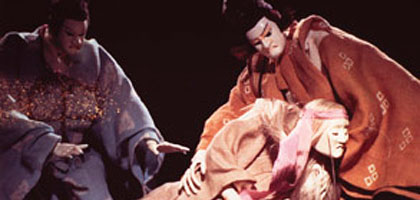Primary navigation


Kawamoto Kihachiro's stop-motion animations are brimming with life, breath and soul. Tim Lucas is captivated
The Exquisite Short Films of Kihachiro Kawamoto
Kawamoto Kihachiro; Japan 1968-79; KimStim Collection/Kino on Video; 99 minutes; Aspect Ratio 4:3
The Book of the Dead
Kawamoto Kihachiro; Japan 2005; KimStim Collection/Kino on Video; 70 minutes; Aspect Ratio 4:3
One of the fascinations of stop-motion animation - the frame-by-frame movement of three-dimensional figures - is that each of its practitioners, from Ladislas Starewitch to Ray Harryhausen to Phil Tippett, has generated styles of movement and modes of storytelling entirely their own. The same can be said of contemporary Japanese animator Kawamoto Kihachiro (born 1925), whose puppets borrow principles of construction from the likes of George Pal and Jiri Trinka yet somehow convey an illusion of life and breath found nowhere else in the history of this artform. Kawamoto's characters may be unblinking but they are brimming with soul; the viewer is captivated by their scarves carrying on the wind, the special way the women's heads bob as they talk, and by Kawamoto's attentive and loving animation of horses. His puppets also embody allusions to other artforms, having the porcelain delicacy found in fine pottery and being garbed in fabrics whose unique colours, fanciful patterns and tactile qualities pop off the screen, everything about them enhancing one's appreciation of the essentially handmade nature of Kawamoto's art. Likewise, the stories Kawamoto chooses to tell are - the KimStim Collection has found the right word - exquisitely meditative, spiritual without being humourless, and oblique in ways that resonate rather than frustrate.
As an introduction to the film-maker, The Exquisite Short Films of Kihachiro Kawamoto is dazzling but also unsteadying in its diversity. While the seven shorts it collects are an unalloyed delight, they are surprisingly mercurial in form and approach, and the word 'short' isn't an accurate description. Three of the films are close to 20 minutes in length and even the shortest, at seven or eight minutes, achieve a contemplative plane that seems to elongate time. Not to suggest that these miniatures are overlong or boring; on the contrary, they have a substance that belies their brevity.
The collection begins with 1968's The Breaking of Branches Is Forbidden, a Zen-like treatise on responsibility in which a monk's foolish young apprentice lets his fondness for sake eclipse his duty to master and nature. Here, Kawamoto's three-dimensional figures are positioned against spare, elegantly designed backdrops evocative of ancient Japanese tapestries. Nothing about it prepares you for the completely different approach of An Anthropo-Cynical Farce (1970), a social satire in the guise of a dog race, combining puppet and line animation, made in high-contrast black and white and with artificial 'photographic' grain impressed on some parts by filming the puppets and drawings through a coarse black stocking. The Demon (1972), based on a tale from the 12th-century ghost anthology Konjaku Monogatari, uses three-dimensional figures and sets to tell a story of possession; the colour image here is so exceptionally detailed it could pass for high definition. The Trip (1973) is the most radical of the shorts, combining still photography (à la La Jetée), traditional two-dimensional animation of the untraditional Terry Gilliam variety, and backgrounds inspired by M.C. Escher. In The Poet's Life (1974), based on a story by Abe Kobo (The Woman of the Dunes), Kawamoto employs a sepia-toned charcoal style to tell a weird tale of oppression and transformation: an overworked factory weaver is absorbed into the yarn she is spinning and becomes reconfigured as a bloodstained sweater. Dojoji Temple (1976) follows an aged monk and his disciple on an adventure involving a witch who can transform herself into a fire-breathing dragon, and Temple of Fire (1979, called 'House of Flames' on the packaging) is a moving parable about a woman loved by two suitors whom she loves equally, who takes her own life to avoid choosing between them, leaving them to bond with one another and her death.
It's a heady collection, absorbing in its steady layering of media and technique, but best taken in small sips. It does, however, provide a valuable road map of nascent themes and techniques that achieve full bloom in Kawamoto's feature-length masterpiece The Book of the Dead. If 20 minutes is long for a short, The Book of the Dead is short for a feature - less than 70 minutes. But again, in its metaphysical probing it seems to disengage from time and leaves one awed by all it accomplishes within such limitations. Narrated in English with all dialogue in subtitled Japanese, it is the eighth-century story of Lady Iratsume, a reclusive noblewoman who is persuaded by a vision to make a solitary journey to a distant temple. En route, she arrives at a spot where, 50 years earlier, the nobleman Prince Otsu was beheaded. They experience a mutual, mystic connection: she mistakes his radiantly bleached ghost for a vision of Buddha, and he mistakes her for the beautiful stranger whose face was the last he saw before his decapitation. Rich in character and continually astounding in incident and artistic execution, The Book of the Dead keeps rare company with the likes of Peter Ibbetson (1935), Portrait of Jennie (1948) and Kieslowski's Three Colours Red (1994) as one of the great inexplicable love stories of the cinema. It is also a deeply moving reminder of what heights of magic movies can still achieve when they deign to be created entirely by hand.